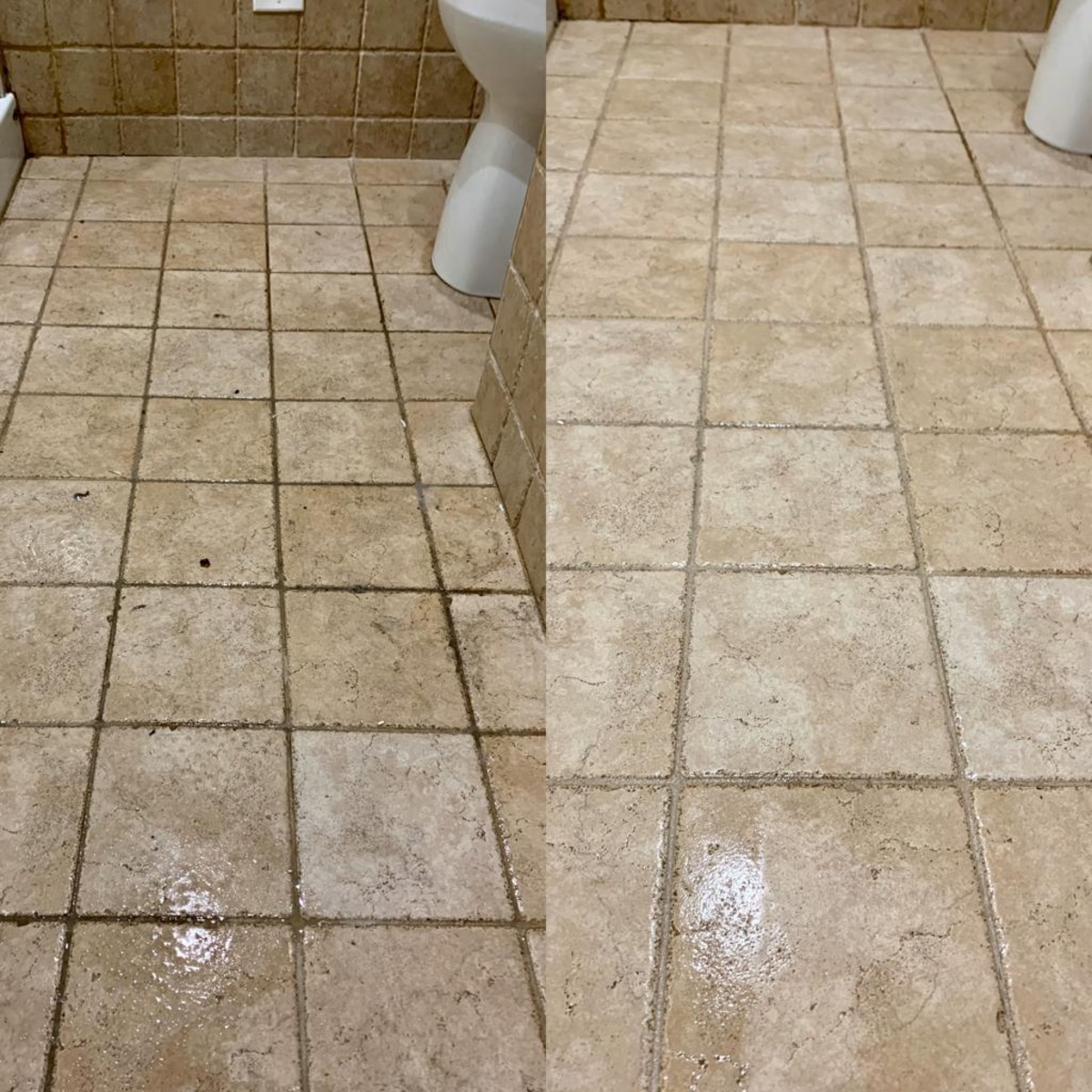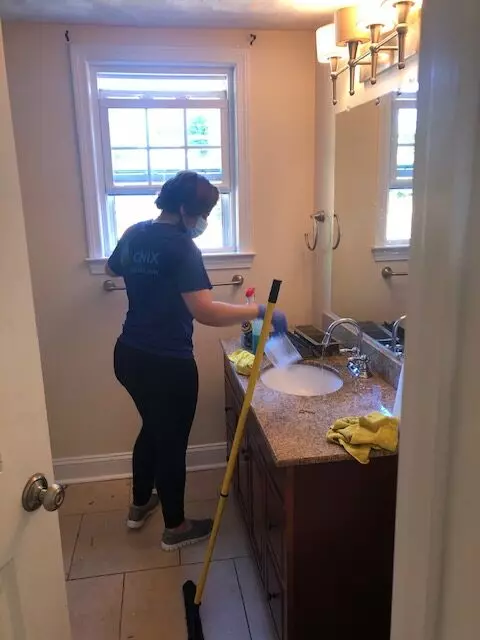3 Best Methods for Getting Rid of Mold in Your Bathroom

A stuffy nose, wheezing, and itchy eyes are three of the many ill effects of mold in the bathroom. Worse, it can cause breathing problems and infections.
Aside from health issues, bathroom mold causes structural damage as it slowly breaks down your bathroom. If you have mold growing in your bathroom, it’s best to address it QUICKLY.
Cleaning mold spores may be challenging, but we’ve written this guide to help you.
This comprehensive guide teaches you how to get rid of stubborn mold in the bathroom and keep your bathing space clean and hygienic.
Ready to know how to clean mold and achieve your bathroom goals? Keep reading!
Understanding Mold
Before getting rid of mold, it helps to understand what it is in the first place.
Mold (or mildew) is a fungal growth caused by moisture or decaying items. Indoor mold, commonly black mold (Stachybotrys chartarum), is usually found on your bathroom ceiling and wall and is usually caused by excess moisture.
Once these black mold spores settle onto your bathroom’s surfaces, expect them to multiply and form mold colonies.
What is Mold, and Why Does it Grow?
Black mold grows and thrives in moisture and decaying materials.
It flourishes in environments with a CONSISTENTLY MOIST and moderate temperature, like the bathroom.
Once black mold settles on the surfaces of a damp bathroom, it will slowly reproduce by releasing tiny airborne spores. This new black mold will eventually find more moldy surfaces to populate.
Health Risks Associated with Bathroom Mold
Bathroom mold degrades health conditions. To give light to this issue, here are some health risks associated with the growth of black mold in the bathroom:
- Triggering allergy symptoms like stuffy nose, wheezing, itchy eyes, and throat
- Breathing difficulties for individuals with existing lung conditions
- Headaches and fatigue
- Aspergillosis, which gives way to coughing, fever, weight loss, and coughing out blood
- Bronchitis, which develops symptoms of shortness of breath, wheezing, and sore throat, among others
Set Up Your Work Area
Knowing what mold is and how it spreads is one thing, but it’s also good to know how to set up your work area.
You must gather the necessary supplies for bathroom mold removal and follow SAFETY PRECAUTIONS while working with mold to prevent accidents, health issues, and more.

Necessary Supplies for Bathroom Mold Removal
Before going straight into the cleaning process, you must prepare all the necessary supplies for cleaning bathroom ceiling mold (and other areas).
Here are the items you’ll need:
- Borax solution (a white mineral powder)
- Bleach solution
- Distilled white vinegar solution
- Hot water
- Spray bottle
- Scrub brush or old toothbrush
- Goggles
- Gloves
- N-95 or P-100 respiratory mask
- Clean rag
- A fan for ventilation, big or small
Safety Precautions While Working with Mold
Working with more mold in the bathroom is a tough job. It can HARM your health if you don’t observe safety precautions.
To take care of your well-being while cleaning a moldy surface and using various cleaning products, here are the things you MUST do:
- Always wear your respiratory mask, goggles, and gloves.
- Don’t touch moldy surfaces and cleaning products with your bare hands.
- Wear old clothes you can dispose of or put in the laundry for extensive washing right after use.
- Don’t let anybody step inside moldy areas, especially when they’re not wearing safety clothing and protective gear.
- Clean mold from surfaces with caution. If the items are nearly impossible to use, dispose of them properly.
How to Get Rid of Mold in Bathroom
Alright, now it’s time to get rid of mold in the bathroom! There are three methods you can use to achieve this goal: traditional, natural, and advanced methods.
Traditional methods involve the use of bleach and hydrogen peroxide, while natural methods typically use a white vinegar solution and baking soda. Advanced methods, on the other hand, involve hiring a professional mold removal service.
Traditional Methods of Mold Removal
You will use bleach or hydrogen peroxide to remove bathroom mold in between tile grout, on the bathroom ceilings, tiled walls, bathroom walls, your shower stall, glass doors, and other areas.
Both are products effective in removing mold, but you can make the process more EASY and EFFICIENT by following the proper procedures.
- Using Bleach to Remove Mold
- Bleach-based cleaners kill mold and sanitize the affected area to prevent bathroom mold from growing.
- However, bleach is only effective when used on non-porous surfaces like tiled walls and sinks. Bleach can DAMAGE the cellular structure of wood surfaces.
- To clean mold using bleach, here are the steps you need to observe:
- Observe safety precautions
- Put the bleach on your tiles or sink and let it sit for 30 minutes
- Scrub using a stiff brush until the mold stains disappear, and rinse with warm water
- You need to remember that you cannot use bleach on colored grout lines as the cleaning solution can cause discoloration.
- Mold Removal with Hydrogen Peroxide
- Aside from bleach, hydrogen peroxide is also frequently used in removing mold. It’s a safer option than bleach as it does not produce toxic fumes and residue.
- If you want to use hydrogen peroxide to clean mold, do these steps:
- Observe safety precautions
- Get your spray bottle and pour 3% hydrogen peroxide concentration
- Spray the surface mold with the solution and let it sit for 10 minutes
- Scrub using a stiff brush until the mold stains disappear
- Wipe the surface to remove residue
Natural Methods of Mold Removal
For individuals who want a more natural way of cleaning mold, white vinegar and baking soda are excellent options for mold cleaners.
- Using Vinegar to Remove Mold
- White vinegar is EFFICIENT in cleaning mold. Here are the steps on how to use it:
- Observe safety precautions and find mold
- Get your spray bottle and pour white vinegar concentration (you can also add drops of essential oil)
- Spray the cleaning product on the surface mold
- Let the solution sit for 1 hour to maximize the cleaning power
- Wipe the surface to remove visible mold and residues
- Using Baking Soda to Remove Mold
- If you want something that kills mold and absorbs moisture to prevent mold growth, baking soda is the way to go. Here is how to efficiently use baking soda:
- Observe safety precautions
- Get your spray bottle and pour two parts baking soda and put warm water in it; mix
- Spray the cleaning solution on the surface mold
- Remove the mold using a sponge or a scrub
- Rinse the surface with water to remove residue
- Spray with the solution and let it dry
Advanced Methods of Mold Removal
When DIY mold removal products and techniques can’t resolve your mold problem, it is time to apply advanced mold removal methods.
Advanced methods involve hiring a professional mold cleaning service to properly diagnose and tackle your mold problem. Read on to know when to call for professional help.
- Hiring a Professional Mold Remediation Service
- Calling for professional help is the best course of action for individuals with mold problems like the following:
- When the mold is inside the heating, ventilation, and air conditioning (HVAC) system
- When the adverse health effects of mold are slowly affecting you and your family
- When the mold issue is beyond your control, and the contaminated area is larger than 2 square feet
Prevention Strategies for Bathroom Mold
Are you familiar with the saying, “An ounce of prevention is worth a pound of cure?”
Yes, you can prevent mold from growing and thriving by enabling proper ventilation and airflow in your bathroom, establishing a regular cleaning schedule, and using mold-inhibiting products.
Proper Ventilation and Airflow
Ensure that your bathroom has GOOD VENTILATION, and there’s nothing blocking the airflow from inside and out.
You can do this by installing a bathroom fan or bathroom exhaust fan and turning it on before, during, or after using the bathroom.
You can also open your windows while you shower, whether you’re using cold or hot water.
Regular Cleaning Schedule for Bathroom
You must also ensure regular cleaning is a part of your bathroom routine. That doesn’t just mean cleaning your bathroom ceiling, bathroom walls, and bathroom tile. It also means washing and drying your damp towels, rugs, and curtains.
The frequency of regular bathroom cleaning is either after every use or twice a week to control dampness inside the bathroom.
Use of Mold Inhibiting Products
Controlling and inhibiting mold growth is possible by picking up the optimal cleaning products for your bathroom and following our tips. You can also use inhibitors like the following:
- Mold and mildew inhibitors
- Silicone anti-mildew sealants
- Mold-resistant paint
Frequently Asked Questions
Learn more about keeping your bathroom clean and mold health issues here!
Can Bathroom Mold Make You Sick?
Mold can make you sick because of its musty smell and other characteristics. Some of its effects include allergic reactions, headaches, and breathing problems.
Is It Safe to Remove Mold in Bathroom by Myself?
It’s safe to remove mold in bathroom and laundry rooms by yourself if you observe safety precautions and if the moldy area is not larger than 2 square feet.
If you’re dealing with a moldy area that’s 2 sq. feet or larger, it’s time to hire a professional mold removal service.
Can I Permanently Prevent the Growth of Mold in My Bathroom?
You can PERMANENTLY PREVENT mold with proper ventilation, regular cleaning, keeping your bathroom dry, and using inhibitors.
Is Bleach the Only Chemical That Can Kill Bathroom Mold?
Bleach isn’t the only chemical that can kill mold. You can also use hydrogen peroxide.
How Often Should I Clean My Bathroom to Prevent Mold Growth?
You should clean your bathroom after every use or twice weekly to ensure its cleanliness. This also helps in preventing mold growth, as well as grime and stain buildup.
Conclusion
Mold is a fungal growth that can affect your health and bathroom structure if you allow it to grow rampant.
To combat mold, set up your work area, observe safety precautions, and use traditional, natural, or advanced methods, depending on your needs.
Nevertheless, always make sure your bathroom has excellent airflow and is cleaned regularly. Also, don’t forget to use an inhibitor that prevents mold.
If you are in doubt, don’t hesitate to reread this complete guide and follow the tips we have for you. Surely, you’ll get rid of molds in no time!
Written by
Maria DeSouza

Maria De Souza is a committed and accomplished entrepreneur in the cleaning industry, possessing an extraordinary blend of leadership, vision, and knowledge. As the proud owner of Onix Cleaning Services in Boston, Massachusetts, Maria has over two decades of experience in the industry, delivering unparalleled service and maintaining the highest standards of cleanliness.

